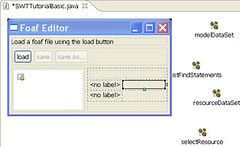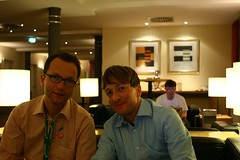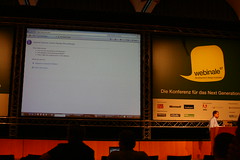flickr::backup and RDF
Thanks to the CPAN Perl community, you can get all your Flickr pics as RDF-if you have linux, its just a few steps away.
The relevant documentation:
documentation as Aarons tool and the other tools used. It is minimal, it is simple, it doesn't miss one point.
He has example RDF output and example documentation, how to tie everything together was easy to find out using CPAN.org.
You will need a flickr API key and secret.
At this point, you need also the auth_token of the key, this is trickier to do.
I moved sidewards to get the token, as I coded with flickr before,
I had a PHP application running that I used to get the auth_token.
The php-flickr API was Dan Coulter's phpFlickr Class 2.1.0,
and it has this getToken.php file that you can tweak to do the right thing.
I am sure you can get the same with Perl. Once you got the key, secret, and auth_token, install the libs:
get Perl (well, a typical linux distro depends heavily on Perl, so you probably have it already).
get the CPAN module for Net::Flickr::Backup, I used the perl cpan shell for this (sudo is needed because it installs the perl modules in the shared libs):
Once you have it installed (perl will say if it doesn't), you can run the Backup by writing a script.
I created two files, one for the config, one for the perl that runs:
flickrbackup.config: (note: the aaaaaa are used to hide my secret keys)
runbackup.pl:
Now run the scripts:
Lean back and watch the photos + RDF manifest in your filesystem magically. In this case, RDF as a file format is helpful becaue it allowed Aaron to mix different aspects of the metadata.
You may get an error because some XML library misses, my error message contained
"Can't locate XML/LibXML.pm in @INC"
Luckily, this mailinglist post tells you what to do:
The relevant documentation:
- http://www.aaronland.info/perl/net/flickr/backup/ - docu of Aaron Straup Cope's flickr backup tool
- http://www.flickr.com/services/api/auth.howto.web.html - how to get a flickr key
documentation as Aarons tool and the other tools used. It is minimal, it is simple, it doesn't miss one point.
He has example RDF output and example documentation, how to tie everything together was easy to find out using CPAN.org.
You will need a flickr API key and secret.
At this point, you need also the auth_token of the key, this is trickier to do.
I moved sidewards to get the token, as I coded with flickr before,
I had a PHP application running that I used to get the auth_token.
The php-flickr API was Dan Coulter's phpFlickr Class 2.1.0,
and it has this getToken.php file that you can tweak to do the right thing.
I am sure you can get the same with Perl. Once you got the key, secret, and auth_token, install the libs:
get Perl (well, a typical linux distro depends heavily on Perl, so you probably have it already).
get the CPAN module for Net::Flickr::Backup, I used the perl cpan shell for this (sudo is needed because it installs the perl modules in the shared libs):
> sudo perl -MCPAN -e shell
in the perl shell, install the backup module:
> install Net::Flickr::Backup
Now, it asks you many questions. In my case, pressing return most of the time did a good job.Once you have it installed (perl will say if it doesn't), you can run the Backup by writing a script.
I created two files, one for the config, one for the perl that runs:
flickrbackup.config: (note: the aaaaaa are used to hide my secret keys)
[flickr]
api_key=1025521456c3212a4f84032049cee7a1
api_secret=aaaaaaaaaaaaaaaa
auth_token=aaaaaa-aaaaaaaaaaaaaa
api_handler=LibXML
#[search]
#tags=cameraphone
#per_page=500
[backup]
photos_root=/home/media/photos/flickrbackup
scrub_backups=1
fetch_medium=0
fetch_square=0
force=0
[rdf]
do_dump=1
#rdfdump_root=/home/asc/photos
api_key=1025521456c3212a4f84032049cee7a1
api_secret=aaaaaaaaaaaaaaaa
auth_token=aaaaaa-aaaaaaaaaaaaaa
api_handler=LibXML
#[search]
#tags=cameraphone
#per_page=500
[backup]
photos_root=/home/media/photos/flickrbackup
scrub_backups=1
fetch_medium=0
fetch_square=0
force=0
[rdf]
do_dump=1
#rdfdump_root=/home/asc/photos
runbackup.pl:
use Net::Flickr::Backup;
use Log::Dispatch::Screen;
use Config::Simple;
my $cfg = new Config::Simple(filename=>"flickrbackup.config");
my $flickr = Net::Flickr::Backup->new($cfg);
my $feedback = Log::Dispatch::Screen->new('name' => 'info',
'min_level' => 'info');
$flickr->log()->add($feedback);
$flickr->backup();
use Log::Dispatch::Screen;
use Config::Simple;
my $cfg = new Config::Simple(filename=>"flickrbackup.config");
my $flickr = Net::Flickr::Backup->new($cfg);
my $feedback = Log::Dispatch::Screen->new('name' => 'info',
'min_level' => 'info');
$flickr->log()->add($feedback);
$flickr->backup();
Now run the scripts:
>perl runbackup.pl
Lean back and watch the photos + RDF manifest in your filesystem magically. In this case, RDF as a file format is helpful becaue it allowed Aaron to mix different aspects of the metadata.
You may get an error because some XML library misses, my error message contained
"Can't locate XML/LibXML.pm in @INC"
Luckily, this mailinglist post tells you what to do:
>sudo apt-get install libxml-libxml-perl
This may fail with some weird message, I ignored this and run my backup script again.|
leobard - 31. Jul, 09:29
|
|
- 0 trackbacks


















XML-RDF : Baum-Graph
ich bin erstaunt über die Aussage: "XML, das aus Bäumen besteht, auf Graphen zu beschränken. Im Prinzip heißt das: ich lasse Teile des XML-Baumes weg, um eine einfachere Struktur zu haben. Diese kann ich dann sehr effizient in eine Datenbank speichern und dann viel besser abfragen als man das von XPath oder XQuery gewohnt ist."
Kannst Du mir das etwas genauer erläutern?
Für mich gilt: XML ist ein Baum mit einer Wurzel, RDF ist ein Graph. Ein Graph ist eine komplexere Struktur als ein Baum, man lässt keine Teile weg, beschränkt also nicht, sondern fügt hinzu. Ein Graph erhöht außerdem die Komplexität für die Anfragebearbeitung (fehlende Ordnung, etc)
Viele Grüße,
Bastian
RDF/XML ist eine beschränkung von XML
s - p -o (siehe rdf primer).
während im XML graph baumstrukturen sind, man kann etwa das hier machen (ohne klammern, geht nicht hier)
root / knoten / knoten / wert.
root / knoten / wert.
root / knoten / knoten / knoten.
rdf/xml ist:
root / knoten / predicate / knoten / predicate / knoten
vereinfacht gesagt, jede zweite stufe im XML baum ist ein knoten, dazwischen immer die predicate.
XML kann auch Text mit elementen mischen, und vieles andere, das in RDF fehlt.